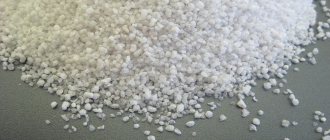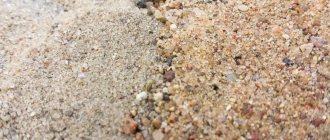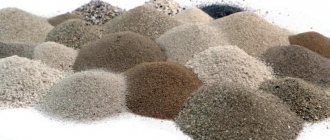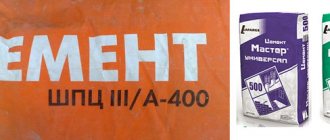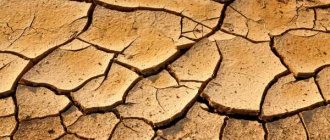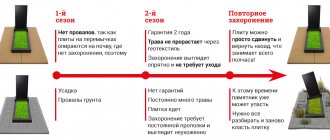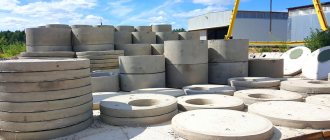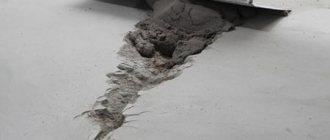Sand of any type and origin contains grains of different sizes, from 0.15 to 5 mm. Anything less or more than the specified numbers is not considered such, even if it is included. The sand fineness module is a conditional value; it shows the grain size and which group the selected batch belongs to. Without the participation of sand material, it is impossible to make concrete or structures from it. It acts to bind cement, water and crushed stone. The grain size affects the amount of cement in the solution and the viscosity in general. The finer the grain composition, the greater the consumption of cement, and this increases the cost and negatively affects the quality of the product. The sand coarseness modulus is taken into account in plastering and adhesive mixtures; the finer the grains, the higher the water absorption of the mass.
What is the modulus of sand fineness measured in?
Documented size is prescribed by the designation Mkr. There is a misconception that the unit of measurement is the millimeter. In fact, this value is conditional; there is no unit of measurement for this purpose. But, if we talk about the fraction, it is written in millimeters and shows the physical size of the building material.
Sand for concrete: which one is better to choose
In order to get a high-quality mass and not make a mistake in choosing when purchasing, you should know what kind of sand is used for concrete. Specialist builders prefer river water because of its following properties:
- homogeneous monolithic texture;
- smooth polished surface;
- high density;
- ideal grain size;
- perfectly fills the voids between particles of crushed stone.
It is usually sold in 40kg bags.
Criterias of choice
State standards determine the permissible amount of impurities in the composition. At the same time, the standards indicate the mandatory absence of humus and additional plant elements.
Attention! When choosing, experts recommend paying special attention to the quantitative indicator of clay admixture. If there is too much of it, the concrete mixture will be “afraid” of frost and crack with the onset of cold weather.
Clay admixture in sand Source sciencetis.com
Formula and calculation method
To determine the particle size, a selected dry batch weighing 2 kg is sifted through sieves with holes:
- 0,1;
- 0,3;
- 0,65;
- 1,25;
- 2,5.
The selected residues are weighed and the results are recorded. After sifting, each sieve is shaken onto a sheet of paper. If nothing spills onto the paper, the process is considered completed.
Using certain formulas, the physical size of the selected batch is calculated. After analyzing the results, a batch of raw materials is assigned to a certain group, depending on the grain size:
- 1-1.5 - very small;
- 1.5 - 2 small;
- 2 - 2.5 average;
- 2.5 and above - large.
To calculate the particle size modulus, weighing results are taken and calculated using the formula: Mkr = (B 1 + B1.5 + B2 + B2.5): 100, where B is the percentage of the total mass of residues on the sieves. After mathematical manipulations, we see the weighted average number of grains of sand per unit mass. The more large grains in the samples, the higher the Mkr index.
Why is the size of sand grains determined?
Analysis of sand by grain size is of utmost importance in the construction industry, since its characteristics make it possible to determine the grade of the material and its suitability for use in a mortar or layer.
When studying the grain composition of sand by sifting on several sieves, the amount of sand with a particle size of 2.5-5.0 mm, 1.25-2.5 mm, 0.63-1.25 mm, 0.315-0, is determined as a percentage of the total mass. 64 mm, 0.16-0.315 mm.
The obtained measurement data makes it possible to construct a sieving curve, which characterizes its granulometric composition and gives an understanding of which concrete mixtures the material can be used in. An integrated display of grain composition characteristics is the fineness module.
Properties of sand
Our ]Werton[/anchor] specialists recommend that before purchasing a material, you familiarize yourself with its technical properties and scope of use. The technology for calculating the need and its type is based precisely on these indicators. According to the extraction method, there are three types:
- career;
- river;
- nautical.
The career variety is most popular among the population for household needs. The composition is heterogeneous, with suspensions of clay, fine crushed stone, and plant residues. The cost is the lowest, affordable, due to the ease of production.
It is not used in its original form in critical areas due to harmful additions. To expand the scope of application, it is sifted on special sieves, thus the raw material is cleaner and denser in its mass. The surface of the grains of sand is cube-shaped and rough to the touch, which is a big plus for this consumable. It is because of this that it is used for mixing concrete.
Washed quarry sand is a modified consumable option. After extraction, it is washed using special equipment; after such procedures, it is suitable for most jobs. The absence of clay has a positive effect on the strength and durability of the product.
River is considered the ideal type for all work. The scope of use is wider and more universal. Nature and water made the surface smooth, pleasant to the touch, without clay. Such consumables are considered to be a naturally pure material that is used in a wide variety of fields. But, due to the oval shape of the grain, the solution must be stirred frequently - it quickly settles to the bottom. This type is especially indicated for soil drainage in garden plots; for this, the largest fraction is taken.
Sea sand also has its niche, the cost is higher than others, and often requires additional cleaning. It is washed to remove mineral deposits, salts, and fresh water. After such manipulations, it can be used for mortars or plaster. Without washing, after masonry work, white deposits and salt appear. The rounded shape of the grain dictates its special places of application, mainly the decoration of park recreation areas, fountains, and paths.
Artificial material is obtained by crushing minerals - marble, quartz and other rocks. This type is used in creating textured adhesive mixtures for decorating various objects.
Next, let’s look at natural sand by fraction:
- fine fraction 1.5 - 2.0 mm, used for concrete, creating dry mixtures, landscape design;
- average 2.0 - 2.5 mm, concrete mortar for foundations, concrete products;
- large 2.5 - 3.0 mm, priority type for reinforced concrete structures, ready-mixed concrete, asphalt concrete;
- an especially large variety of 3.0 - 3.5 mm is used for drainage layers, for blind areas, under the foundation to create a sand cushion; landscape works.
The actual grain size of the sand directly affects where it is used. Even sand dust, industrial waste, is used in winter to sprinkle roads and paths during icy conditions. Products must be waste-free; a thrifty owner will find a use for any product.
Bulk density is the best indicator for the middle fraction of washed or seeded quarry sand. Due to their angular shape, the grains fit tightly to each other. Frost resistance is high and approximately the same for all; this indicator indirectly indicates the durability of the product.
Sand for concrete: quality control
Before making a concrete mix, there are 5 steps to check the quality. To do this you will need a 1 liter transparent container and water.
Step-by-step instructions on how to determine the quality of sand:
- Pour the test sand into the bottle approximately 0.3 liters of the total liter volume;
- Fill the sand container with water to about 0.5 liters of the total liter volume;
- Rinse the mixture by shaking the container;
- Infusion for 7 minutes;
- Grade.
A bad result will be a coating formed on the surface, which indicates a large number of impurities in the sand.
Quality parameters
The quality of sand for concrete is determined by 4 parameters:
- sand grain size;
- density (determined per cubic meter);
- particle shape;
- degree of contamination.
We have already mentioned the importance of the size of sand grains, the presence of impurities, as well as their ability to promote compaction of concrete.
The shape of sand grains affects the ability of a material to settle in a particular solution Source pesokgroup.ru
All of the above parameters are regulated by state standards. These indicators depend not only on the chemical composition of the material. The extraction method also plays a major role here.
Important characteristics of sand
When choosing materials, it is necessary to take into account a number of technical characteristics. Without such an analysis, the choice may turn out to be incorrect, which will lead to unnecessary waste of funds or complete dismantling of the product. When choosing sand for construction, experts pay attention to certain factors:
- the presence of dust particles and clay, they should not be more than 2% in medium fractions, no more than 3% in coarse-grained form;
- relative humidity of raw materials - no higher than 5%;
- clay lumps - not higher than 0.25% for all types and fractions;
- background radiation not higher than 370 Bq.kg for housing; 740 Bq.kg for roads in populated areas and cities; 1500 Bq, kg for highways;
- bulk density, different by fraction, average value is 1300-1500 kg/m3.
Bulk density is a particularly important factor and is taken into account when calculating weight and volume. If the purchase documents indicate a bulk density of sand of 1800 kg/m3 or higher, this indicates an excessive presence of clay in it.
Conclusion
So, we found out that the cleanest and most popular construction sand is washed quarry sand or river sand. Environmentally friendly, high technical performance allows you to create concrete for various purposes with high strength and durability. This type of concrete can be seen on old dismantled buildings, bricks or rubble. It is impossible to do without modern high-quality materials in construction. Requirements for the quality of the environment are growing from year to year. Before purchasing, it is advisable to inspect the product and feel it with your hands. It must be clean, uniform and dry. The seller is obliged to provide accompanying documents and characteristics of the building materials that you buy from him. The presence of proper documents indicates the reliability of the seller.
From everything described, the main conclusion can be drawn - for various construction tasks it is important to choose the most suitable type of sand. There are no universal solutions, especially when constructing residential buildings and premises.
Sand for concrete mix: why is it needed?
Sand is an essential component in building mixtures, since three main criteria depend on it:
- the shape of the stone prevents deformation of future concrete contraction;
- hardening - helps the solution harden on the surface as quickly as possible;
- strength – promotes thickening and compaction of the concrete mass.
Attention! In the process of mixing the concrete mass, all generally accepted proportions must be strictly observed. Experiments with the ratio of materials most often lead to negative consequences.
What kind of sand should be used for concrete?
3 indicators to determine what sand is needed for concrete :
- foreign impurities – clean sand is most valued (impurities reduce quality, normally they should be no more than 5%);
- texture - in other words, a fraction that affects the bonding function (if a grain of sand is less than 2 mm in size, then the concrete mass will be poor);
- humidity level – taken into account during the process of adding water.
When mixing the solution, you need to find out the humidity indicator so as not to overdo it with water Source wixstatic.com
High humidity
All sands have natural moisture to one degree or another. But only in some of the sands is it increased. These include sea, river, lake and partially alluvial sands - that is, those sands that have been in contact with water for a long time.
How to determine if sand has high humidity? Look at the two samples below:
The sample on the left is quarry sand. It is crumbly, almost dry. Alluvial sand, located on the right, has high humidity. Look how it lies, how porous and loose it seems. In addition, it is very easy to form a lump from it that will not crumble and will keep its shape.
We have looked in detail at the factors that can affect the appearance of sand. It is these characteristics that distinguish some materials from others. Thanks to their combination, you can quite accurately determine what type of sand was brought to you.
You will find a detailed description of how to recognize this or that type of sand on our pages:
- What does alluvial sand look like?
- What does river sand look like?
- What does sea sand look like?
- What does epoxy sand look like?
How is river sand mined?
The extraction of river sand is carried out by a dredger, which includes hydromechanical equipment, including a hydraulic pump, a storage tank and a sieve (see photo below). First, using a powerful pump, the sand mass is collected from the bottom of the river, stored on a barge, then, using a conveyor, it is reloaded onto the shore into dump trucks or to a temporary storage site (depending on the technological process).
Coarse sandy material from the bed of a dry reservoir is extracted using an excavator, then it is loaded into dump trucks and transported to a construction site or warehouse. The entire technological process is very similar to the process of extracting raw materials in a quarry.
Important! According to GOST, the sand must be washed. Otherwise, it is considered substandard and unsuitable for construction work. Raw materials may be washed several times during the extraction process (this depends on the amount of sludge).
After washing, the sand mass must dry to the level of “normal humidity” (regulated by GOST) and only after that can it be transported to a permanent storage site or put on sale.
Presence of dust and clay particles
Dust and clay particles mean very small grains, less than 0.063 mm in size. If there are a lot of them in the sand, it is considered polluted. The presence of such particles significantly limits the range of applications of the material.
As we said above, quartz and epoxy sands contain many grains similar to dust. In addition, quarry sand may be contaminated with small particles. This is due to the fact that quarry sand, unlike river, lake, sea and alluvial sand, does not come into contact with water. After all, it is moisture that can cleanse the material from the smallest impurities.
